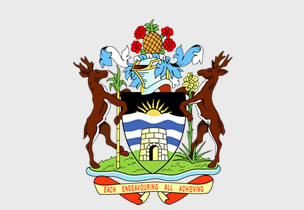Location
The tropical islands of Antigua and Barbuda are located in the heart of the Caribbean about a thousand miles to the east of Jamaica and half that distance from Trinidad on the coast of South America. We are at 17- N latitude, about the same as the Cape Verde Islands and Bombay and 61- W longitude.
The island of Antigua was born out of the sea by a volcano about 30 million years ago. A young island in geologic time. On the northern flank of this volcano, reefs were formed, hence the greater part of Antigua is low lying and is composed of limestone rock.
The highest point of Antigua is 1,319 ft in the south-west and is called Boggy Peak, but the limestone Highlands of Barbuda rise to only 125 ft. The area of Antigua is 108 square miles, while Barbuda is 62 square miles. The population of the former is approaching 80,000, but the latter is relatively unpopulated at 1,300. Days and nights are refreshingly cooled by the gentle trade winds. Antigua boasts the largest expanse of freshwater in the whole of the Caribbean with a lake nearly two miles long by a mile wide.
Barbuda became separated from Antigua by about 28 miles, when the sea-levels of the world rose considerably at about 10,000 BC. Today parts of Barbuda are geologically flooded to form interesting lagoons. Here may be seen the largest breeding and nesting colony of the Magnificent Frigate Bird in the world. Barbuda supports a tremendous diversity of native habitats, as yet unthreatened by development. Reef-fringed Barbuda may be one of the best kept ecological secrets in the West Indies. Her rugged scenery, beautiful beaches, (one at least 12 miles long), lagoons and abundant wildlife may be a resource as valuable as its fisheries.
Members:
Resources
Displaying 16 - 20 of 33Settled Estates Act (No. 16 of 1894).
This Act makes provision with respect to transactions involving and rights inherent to settled estates i.e.
Partition Act (No. 15 of 1895).
This Act sets out the conditions and procedures for the partition of land held by more than one tenant, i.e. joint tenants and tenants in common.Any person entitled to claim partition may apply to Court for partition, which shall, after issue of an order of partition by Court, take place in the matter as specified by this Act. The Court may also direct the sale of the property if it thinks to be more beneficial to the parties involved to distribute proceeds of the sale among them instead of carrying out the partition.
Land Settlement Act (No. 15 of 1939).
This Act makes provision for some aspects relating to the settlement on land. The Cabinet may, by Order, declare any area of Crown land to a settlement area. A settlement area shall be destined for the settlement of small agricultural holdings and the land allocated shall be subject to restrictions as to the disposal of the land and crops thereon. The Act further provides for regulation-making powers of the Cabinet.
Non-citizens Undeveloped Land Tax Act (No. 14 of 1978).
This Act formulates a duty of non-citizens to develop land held in ownership, grants powers to the Minister to declare land held by non-citizens to be underdeveloped land and imposes an annual tax on the value of such underdeveloped land.In determining whether a non-citizen is fulfilling his or her responsibility under the Act to develop agricultural land, regard shall be had to the extent to which and the manner in which: (i) pasture is being maintained; (ii) arable land is being cropped; and (iii) the land is stocked where it is being used for livestock farming.
Land Adjudication Act (Act No. 16 of 1975).
This Act sets out the procedures, principles and criteria for the adjudication of land in an area declared to be an adjudication area by Order of the Minister made under this Act. The Act also declares all waste and unoccupied land to be Crown land.The Minister shall appoint an Adjudication Officer who shall be in charge of the adjudication of land in the area. Every person claiming an interest in land in the adjudication area shall observe the procedures and criteria as laid down in this Act.


